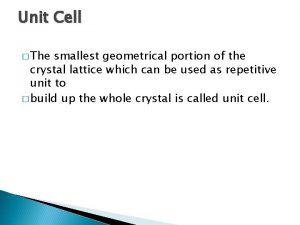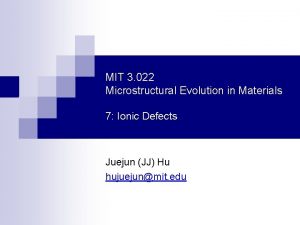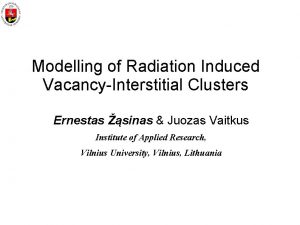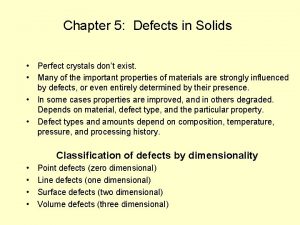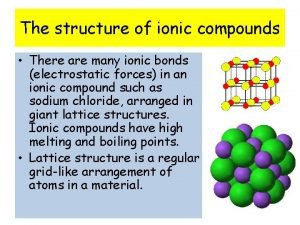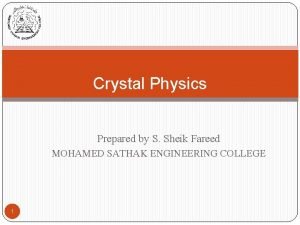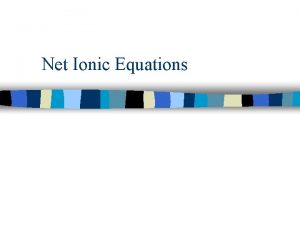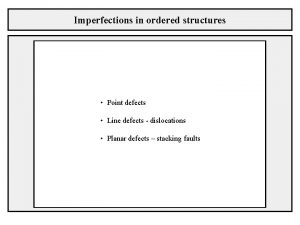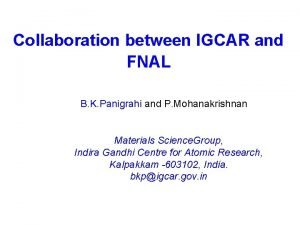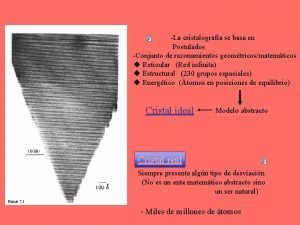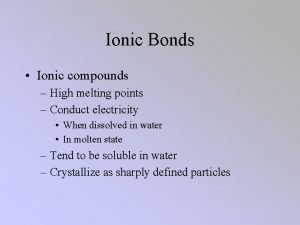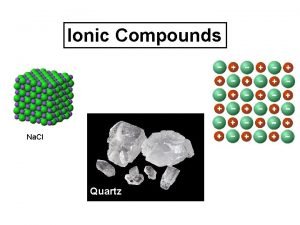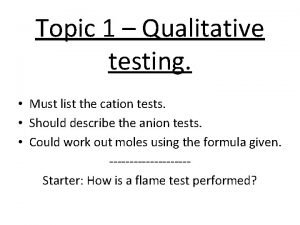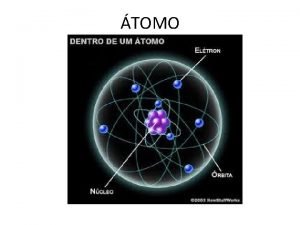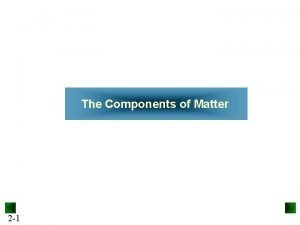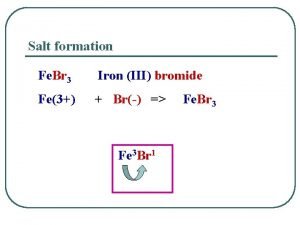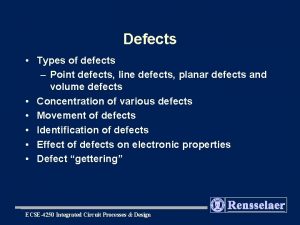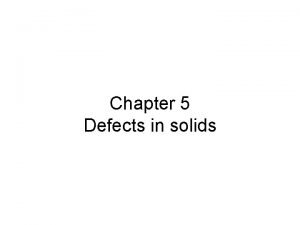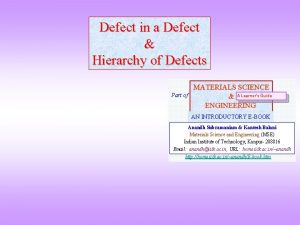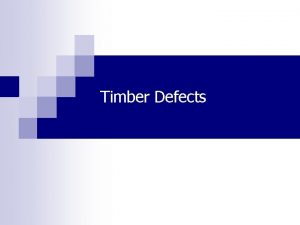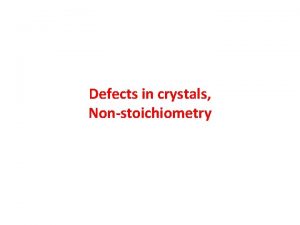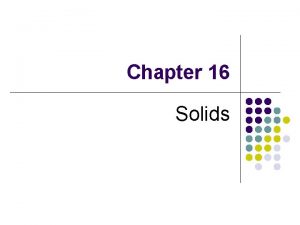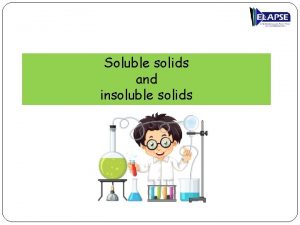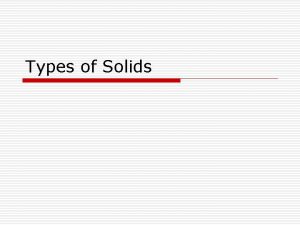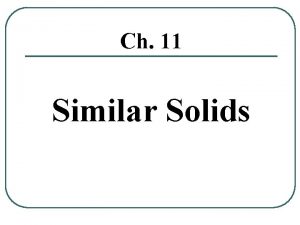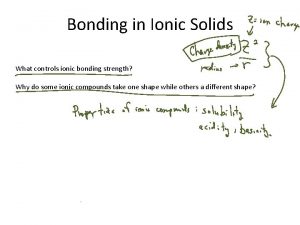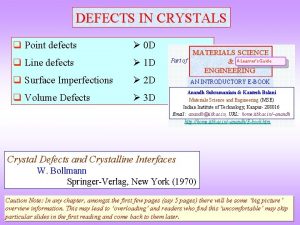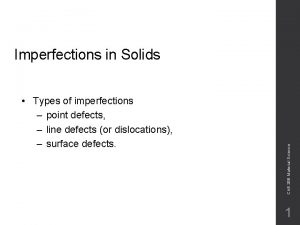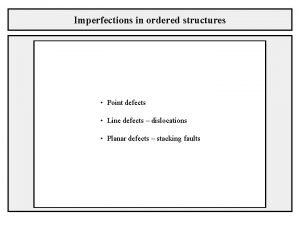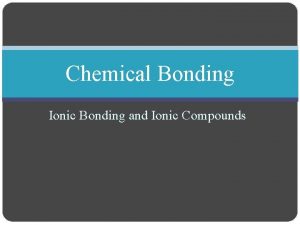Point defects in ionic solids Frenkel defect anion





























- Slides: 29


Point defects in ionic solids Frenkel defect: anion vacancyinterstitial cation pair. Schottky defect: anion-cationvacancy pair. Anti-Schottky defect: anioncation-vacancy plus interstial pair. ee- F-center: anion vacancy with excess electron in alkalihalides. e. M-center: two anion vacancies with one excess electron each. Isovalent substitute atom

Thermodynamics of point defects hf - Free energy of formation for n Schottky defect pairs in Na. Cl: G 0: free energy of the perfect crystal h: enthalpy of formation of a defect s : entropy change n: number of defect pairs T=const. G G G 0 Gmin Consequence of thermodynamic analyses: Above 0 K, point defects will always be present in a crystal that is in thermodynamic equilibrium. The number of point defects will increase with increasing temperature. -T s neq n

Point defects and diffusion I Exchange mechanism Ring rotation mechanicsm Vacancy mechanism Interstitial mechanism The jump of an atom from one site to an adjacent empty side needs 1. the "cooperation" of the neighboring atoms, e. g. the green atoms have to "open" a gap (through termal vibrations) exactly when the red atom tries to jump. 2. that the jumping atom has enough energy to do the movement (activation energy EA ) 3. The number of atoms which have enough energy and the number of ideal geometries increase with increasing temperature.

Point defects and diffusion II C dx x The diffusion rate J in direction x is proportional to a property of the system diffusant/diffusor ( diffusion constant D) and the concentration gradient along x. For a constant gradient the flux (e. g. migration of particles accross a unit area in unit time) is given by Fick's first law as: d 2 C dx 2 > 0 C d 2 C dx 2 < 0 xi x In most cases, however, the concentration gradient is not constant, but changes with time. Fick's second law describes diffusion with non steady-state concentration gradients: Qualitatively, the equations indicates, that in regions where the concentration gradient is convex, the flux (and the concentration) will decrease with time, for concave gradients it will increase. The order of magnitude of the diffusion distance can be calculated by the following thumb rule:

Point defects and diffusion III t Fo 100 T = 1200 °C, 254 h DEMP: 9 x 10 -13 DTEM: 6 x 10 -13 norm. conc. In most cases the diffusion of one species above is not independent of the diffusion of a second species. For example the speed with which green atoms above can move into the red phase depend on the speed with which red atoms move to the left = interdiffusion. The arrangement above, often used to measure interdiffusion, is called a diffusion couple EMP TEM p 1 TEM p 2 Fo 82 1 mm c* T = 980 °C, 336 h Determination of a diffusion profile in a olivine diffusion couple (Meissner et al. , 1998) norm. conc. distance mm TEM EMP distance mm

Point defects and diffusion IV ln D 1/T The diffusion constant increases with temperature. D D 0 EA K diffusion constant preexponential factor activation energy Bolzmann constant The dependency is shown in a ln. D vs. 1/T (= inverse temperature) plot called Arrhenius diagram. Units of D: m 2 s-1 Self- and interdiffusion coefficient in garnets (Schwandt et al. , 1996)


Solid solutions Elements present in a pure phase with an ideal structure can be replaced by other elements. Such a replacement is called a substitution. A solid solution is a single phase which exists over a range in chemical compositions. Pure phases are calle endmembers, while partially substituted phases are intermediate members. Endmember 100% red atoms 0% green atoms Solid solution 89% red atoms 11% green atoms Endmember 0% red atoms 100% green atoms Almost all minerals are able to tolerate variations in their chemistry (some more than others). Chemical variation greatly affects the stability and the behaviour of the mineral. Therefore it is crucial to understand: - the factors controlling the extent of solid solution tolerated by a mineral - the variation in enthalpy and entropy as a function of chemical composition - different types of phase transition that can occur in solid solutions

Olivine solid solution Following rules apply for substitutions: Olivin solid solution: - conservation of charge neutrality - similar size of substituting ion - preference for the same coordination of the substituting ion - similar electronic configuration Forsterite Mg 2 Si. O 4 VI Mg 2+ => VI Fe 2+ Fayallite Fe 2 Si. O 4 Magnesium in octahedral coordination can be replaced by Fe and Mn Cation radii: Mg 2+ : 0. 72Å vs. Vector notation for the substitution: Fe 2+ : 0. 78Å Mg-1 Fe All intermediate compositions between pure Mg-olivine (forsterite) and pure Fe-olivine (fayallite) are possible => complete solid solution

Structural sites and substitutions Cation (anion) positions which are related by symmetry are called sites. Positions with the same polyhedral environment may not represent the same site. In the olivine structure f. ex. there are two octahedral cation positions, which are not related by symmetry, and represent, therefore, two different sites called M 1 and M 2. The two sites are not regular octahedra but are slightly distorted. The distorsion is not equal for both sites. M 1 - site M 2 - site T-site av. M-O bond lengths in M 1: 2. 101 av. M-O bond lengths in M 2: 2. 135 Polyhedral representation of a fragment of the olivine structure viewed down the a-axis. Complete unit cell of the olivine structure In forsterite all octahedra are filled by magnesium, but can be replaced by other cations like Fe, Mn, Ca. Whereas Fe has a weak preference for M 1, Mn and Ca enter preferentially the M 2 site. The latter two are larger than Mg.

Limited solid solution Calcite-dolomite solid solution: Calcite Ca 2(CO 3)2 Cation radii: Ca 2+ : 1. 0 Å vs. Vector notation for the substitution: VI Ca 2+ Mg 2+ : 0. 72Å Ca-1 Mg => VI Mg 2+ Dolomite Ca. Mg(CO 3)2 !! large difference !! Large difference in size => only limited substitution possible => limited solid solution Composition range which is not possible: solution gap, miscibility gap The size of the miscibility gap is temperature dependent: XMg : molar fraction [Mg] T ( C) = [Mg] + [Ca] 1400 1200 1000 800 600 The higher the temperature, the smaller the solutiongap. The diagram on the right is valid if the carbonates are heated in a pure CO 2 atmosphere. 400 200 Miscibility gap 0. 0 0. 1 Calcite 0. 2 0. 3 0. 4 0. 5 Dolomite X Mg

Exsolution The system Na. Cl-KCl has, due to the difference in cation radii (1. 0 vs 1. 4Å) a miscibility gap. Above 410°C a crystal with a composition Na 0. 75 K 0. 25 Cl will be homogeneous, below this temperature, e. g. when cooling the crystal below the solvus, potassium rich exsolution lamellae will form, which grow and become richer in K with further cooling, whereas the matrix will become Na richer. Microstructures T=590°C composition of crystal: M 0 T=410°C composition of matrix (99%) : M 1 exsolution lamellae (1%): Ex 1 M 0 99% M 1 100% M 2 14% T=350°C composition of matrix (86%) : M 2 Exsol. lamellae (14%): Ex 2 Ex 1 Ex 2 86% Ex 3 M 3 24% Halite 76 % Sylvite T=200°C composition of matrix (76%) : M 3 Exsol. lamellae (24%): Ex 3

Exsolution in orthoamphiboles Between amphibole endmembers there are often miscibility gaps, f. ex. between cummingtonite and glaucophane. Cooling of a glaucophane (endmember: Na 2 Mg 3 Al 2 Si 8 O 22(OH)2) with excess Mg and Ca will lead to exsolution of cummingtonite lamellae. The exsolution lamellae are very fine and bearly visible in the optical microscope Cummingtonite lamellae formed within a glaucophane host seen in the TEM. The lamellae form in two symetrically related orientations.

Coupled substitutions Albite-Anorthite solid solution Albite Na. Al. Si 3 O 8 Cation radii: IX Na+ Ca 2+ : 1. 18 Å => Anorthite Ca. Al. Si 3 O 8 IXCa 2+ vs. Na+ : 1. 24 Å ok! but violation of charge neutrality!! conservation of charge neutrality => second exchange Albite Na. Al. Si 3 O 8 IX IV Na+ Si 4+ => => IX Anothite Ca. Al(Al. Si 2)O 8 Ca 2+ IV Al 3+ Two or more substitution at once: coupled substitutions Vector notation for the substitution: Na-1 Si-1 Ca Al. IV charge balance: Na 1+ => Ca 2+ + Si 4+ => Al 3+ : 1 + 4 =2+3 ok!! Vectors are often named after the most prominent occurence. The above vector is called plagioclase vector. Tschermak’s exchange: Diopside Ca. Mg. Si 2 O 6 Si 4+ Mg 2+ IV Al 3+ => => Tschermak’s exchange IV Al. IVAl. VI Mg-1 Si-1 VI VI Al 3+ “Cats”-module Ca. Al(Al. Si)O

Omission solid solutions Substitutions where charge balance is maintained by substituting only a part of the ions taken out is called omission substitution. Such a substitution will leave some sites empty, which are filled in the endmember. Perspective views of the kalifeldspar structure down the c-axis. potassium atoms potassium vacancy lead cation Pb 2+ silicium tetrahedra aluminium tetrahedra K 1+ => Pb 2+ 1 = 2+0 Vector notation: K-21+ Pb 2+ Lead containing kalifeldspar has a green-blue color and is called amazonite.

Substoichiometry Omission substitution through oxidation Iron layer in troilite Fe. S Iron layer in pyrrhotite Fe 1 -x. S metallic Fe Ferrous iron (Fe 3+ ) Ferric iron (Fe 2+ ) Oxidation reaction: 3 Fe 2+ => 2 Fe site, vacancy) 3+ Vector notation: + + Fe 0 (metallic) ( = empty Fe 2+-3 Fe 2+2 The stoichiometry of pyrrhotite can hardly be expressed by integral numbers, such phases are said to be substoichiometric The introduction of trivalent iron occurs often already during the growth of the crystal. If the oxidation occurs later, the reduced iron has to be expelled from the structure.

Interstitial solid solution Substituting ions can also go interstitial sites (interstitial substitution), not occupied in the pure phase. Example: In the ring silicate beryl (Be 3 Al 2 Si 6 O 18) (Fig. 2. 27) alcali cations can lodge into the channels formed by silicate rings, which are empty in the pure phase. Charge balance is reestablished by replacing one silicon by aluminum: Exchange vector: Si-1 Beryl structure seen along the open channels = c-axis Silica tetrahedral aluminum Beryllium tetrahedra alkali cation (e. g. Na+) octahedral aluminum water molecule -1 Al Na Instead of alkali cations, neutral noble gas atoms or water molecules can occupy the channels, which require no charge balancing. Exchange vector: -1 (H 2 O)

Order-disorder I The order in a structure with two cations sharing the same site can be described by an order parameter Q. Disordered substitution Ordered substitution site: potential position for an atom Site Atom A Site Atom B Four possibilities: atom A on site atom B on site Probability of A on : Probability of B on �� 1 - p�

Order-disorder II Complete order : p = 1 Complete disorder: p = 0. 5 Normalizing: long range order Q = 2 p – 1 Another way to define Q is: where the terms Aa is the fraction of atoms A on site . For a phase with stoichiometry Am. Bn , Q is given as: and Disordering occurs not suddenly, but over a certain temperature range below the critical temperature. In the disordered structure it is impossible to predict what atom (green or red) occupies a certain site. Results from bulk property measurements of a disordered crystals are the same as the results from a hypothetical crystal with each site filled with half a green and half a red atom. Disordering is thus accompanied by a change in symmetry. For the example shown on the left, the symmetry would change from facecentered cubic to primitiv cubic.

Order-disorder III Long - vs. short range order bad long, bad short r. o. good long, good short r. o. bad long, good short r. o. boundary between perfectly ordered areas = anti-phase boundaries. The domains are related by a translation that is a fraction of the lattice translation of the ordered structure.

Ordering vs. exsolution Exsolution Cation ordering

Basic elements of the pyroxene structure The pyroxene structure is characterized by single tetrahedral chains (right). Two of them sandwich an octahedral chain (top)

Ortho- vs. clinopyroxenes C 2/c Pbca e. g. diopside Ca. Mg. Si 2 O 6 e. g. enstatite Mg 2 Si 2 O 6

Octahedral sites in pyroxenes

Pyroxene quadrilateral

Ordering in OPX I Octahedral strip of the OPX structure. I-beam representation of the orthopyroxene structure. view is parallel to the silicon tetrahedra.

Ordering in OPX II Fe 2+ is slightly larger than Mg and prefers to sit on the larger M 2 site (i. e. the crystal has a lower enthalpy when Fe 2+ is sitting on M 2). Example: For a composition (Mg 0. 5 Fe 2+0. 5)Si. O 3 M 1 M 2 Mg Fe 2+ Intermediate temperature Mg 1 -x. Fe 2+x Mgx. Fe 2+1 -x “Infinite” temperature Mg 0. 5 Fe 2+0. 5 Low temperature We can measure “x” experimentally and use it to determine what the cooling rate and effective equilibration rate of the mineral was (geospeedometry).

Ordering in OPX III
 Distinguish between schottky and frenkel defect
Distinguish between schottky and frenkel defect Kroger vink notation examples
Kroger vink notation examples Denge koordinasyon egzersizleri
Denge koordinasyon egzersizleri Aproksimasyon nedir
Aproksimasyon nedir Schottky and frenkel defects
Schottky and frenkel defects Vacancy defect and interstitial defect
Vacancy defect and interstitial defect Point defects in crystals
Point defects in crystals Ionic compounds are
Ionic compounds are Radius ratio of ionic solids
Radius ratio of ionic solids Objectives of secondary education commission 1952-53
Objectives of secondary education commission 1952-53 Point defects in crystals
Point defects in crystals Met ionic equation
Met ionic equation Okmc
Okmc Point defect
Point defect Point defect
Point defect Fick kanunu
Fick kanunu Titübasyon nedir
Titübasyon nedir Olga hamlet
Olga hamlet Defecto de schottky
Defecto de schottky Ionic bond melting point
Ionic bond melting point High melting point
High melting point Formula do.anion gap
Formula do.anion gap Anion gap definicion
Anion gap definicion Test for ammonium ions
Test for ammonium ions Massa molecular
Massa molecular Cations and anions list
Cations and anions list Fe(br)3
Fe(br)3 Mudpiles anion gap
Mudpiles anion gap Anion wodorkowy + kation oksoniowy
Anion wodorkowy + kation oksoniowy Urine anion gap
Urine anion gap
